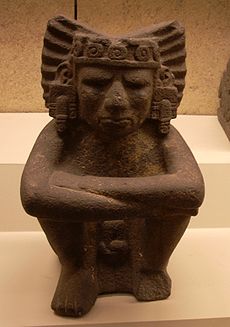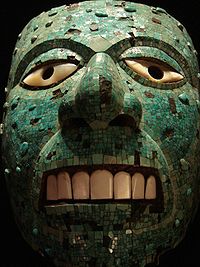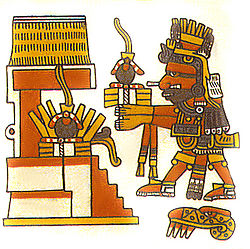
Xiuhtecuhtli
Encyclopedia

Aztec mythology
The aztec civilization recognized a polytheistic mythology, which contained the many deities and supernatural creatures from their religious beliefs. "orlando"- History :...
, Xiuhtecuhtli ("Turquoise
Turquoise
Turquoise is an opaque, blue-to-green mineral that is a hydrous phosphate of copper and aluminium, with the chemical formula CuAl648·4. It is rare and valuable in finer grades and has been prized as a gem and ornamental stone for thousands of years owing to its unique hue...
Lord" or "Lord of Fire"), was the god of fire, day and heat. He was the lord of volcanoes, the personification of life after death, warmth in cold (fire
Fire
Fire is the rapid oxidation of a material in the chemical process of combustion, releasing heat, light, and various reaction products. Slower oxidative processes like rusting or digestion are not included by this definition....
), light in darkness and food during famine. He was also named Cuezaltzin ("flame") and Ixcozauhqui, and is sometimes considered to be the same as Huehueteotl
Huehueteotl
Huehueteotl is a Mesoamerican deity figuring in the pantheons of pre-Columbian cultures, particularly in Aztec mythology and others of the Central Mexico region. He is also sometimes called Ueueteotl...
("Old God"), although Xiuhtecuhtli is usually shown as a young deity. His wife was Chalchiuhtlicue
Chalchiuhtlicue
Chalchiuhtlicue was an Aztec goddess of love, beauty, youth, lakes, rivers, seas, streams, horizontal waters, storms, and baptism. Reputedly universally revered at the time of the Spanish conquest, she was an important deity figure in the Postclassic Aztec realm of central Mexico...
. Xiuhtecuhtli is a manifestation of Ometecuhtli, the Lord of Duality, and according to the Florentine Codex
Florentine Codex
The Florentine Codex is the common name given to a 16th century ethnographic research project in Mesoamerica by Franciscan friar Bernardino de Sahagún. Bernardino originally titled it: La Historia General de las Cosas de Nueva Espana...
Xiuhtecuhtli was considered to be mother and father of the Gods, who dwelled in the turquoise enclosure in the center of earth.
The Nahuatl
Nahuatl
Nahuatl is thought to mean "a good, clear sound" This language name has several spellings, among them náhuatl , Naoatl, Nauatl, Nahuatl, Nawatl. In a back formation from the name of the language, the ethnic group of Nahuatl speakers are called Nahua...
word xiuhuitl means "year" as well as "turquoise" and "fire", and Xiuhtecatl was also the god of the year and of time. In the 260-day ritual calendar
Mesoamerican calendars
Mesoamerican calendars are the calendrical systems devised and used by the pre-Columbian cultures of Mesoamerica. In addition to the basic function of a calendar—defining and organizing periods of time in a way that allows events to be fixed, ordered and noted relative to each other and some...
, the deity was the patron of the day Atl ("Water") and with the trecena
Trecena
A trecena is a 13-day period used in pre-Columbian Mesoamerican calendars. The 260-day calendar was divided into 20 trecenas. Trecena is derived from the Spanish chroniclers and translates to 'a group of thirteen' in the same way that a dozen relates to the number twelve...
1 Coatl ("1 Snake"). Xiuhtecuhtli was also one of the nine Lords of the Night
Lords of the Night
In Mesoamerican calendars, the Lords of the Night are a set of nine gods that ruled over a particular night. They were cyclical, so that same god recurred every nine nights.In the Aztec calendar, the Lords of the night are...
and ruled the first hour of the night, named Cipactli ("Alligator"). Xiuhtecuhtli was the patron god of the Aztec emperors, who were regarded as his living embodiment at their enthronement. The deity was also one of the patron gods of the pochteca
Pochteca
Pochteca were professional, long-distance traveling merchants in the Aztec Empire. They were a small, but important class as they not only facilitated commerce, but also communicated vital information across the empire and beyond its borders. The trade or commerce was referred to as pochtecayotl...
merchant class.
Stone sculptures of Xiuhtecuhtli were ritually buried as offerings, and various statuettes have been recovered during excavations at the Great Temple of Tenochtitlan with which he was closely associated. Statuettes of the deity from the temple depict a seated male with his arms crossed. A sacred fire was always kept burning in the temples of Xiuhtecuhtli. In gratitude for the gift of fire, the first mouthful of food from each meal was flung into the hearth.
Attributes

Xochiquetzal
In Aztec mythology, Xochiquetzal was a goddess associated with concepts of fertility, beauty, and female sexual power, serving as a protector of young mothers and a patroness of pregnancy, childbirth, and the crafts practised by women such as weaving and embroidery...
and other deities.
Many of the attributes of Xiuhtecuhtli are found associated with Early Postclassic
Mesoamerican chronology
Mesoamerican chronology divides the history of pre-Columbian Mesoamerica into several periods: the Paleo-Indian , the Archaic , the Preclassic , the Classic , and the Postclassic...
Toltec
Toltec
The Toltec culture is an archaeological Mesoamerican culture that dominated a state centered in Tula, Hidalgo in the early post-classic period of Mesoamerican chronology...
warriors but clear representations of the god are not common until the Late Postclassic
Mesoamerican chronology
Mesoamerican chronology divides the history of pre-Columbian Mesoamerica into several periods: the Paleo-Indian , the Archaic , the Preclassic , the Classic , and the Postclassic...
. The nahual, or spirit form, of Xiuhtecuhtli is Xiuhcoatl
Xiuhcoatl
In Aztec religion, Xiuhcoatl was a mythological serpent, it was regarded as the spirit form of Xiuhtecuhtli, the Aztec fire deity, and was also an atlatl wielded by Huitzilopochtli...
, the Fire Serpent.
Xiuhtecuhtli was embodied in the teotecuilli, the sacrificial brazier into which sacrificial victims were cast during the New Fire ceremony
New Fire ceremony
The New Fire ceremony was an Aztec ceremony performed once every 52 years — a full cycle of the Aztec calendar— in order to stave off the end of the world....
. This took place at the end of each cycle of the Aztec calendar round (every 52 years), when the gods were thought to be able to end their covenant with humanity. Feasts were held in honor of Xiuhtecuhtli to keep his favors, and human sacrifices were burned after removing their heart
Heart
The heart is a myogenic muscular organ found in all animals with a circulatory system , that is responsible for pumping blood throughout the blood vessels by repeated, rhythmic contractions...
.
Annual festival
The annual festival of Xiuhtecuhtli was celebrated in Izcalli, the 18th veintenaVeintena
A veintena is the Spanish-derived name for a 20-day period used in pre-Columbian Mesoamerican calendars. The division is often casually referred to as a "month", although it is not coordinated with the lunar cycle...
of the year. A framework image of the deity was constructed from wood and was richly finished with clothing, feathers and an elaborate mask. Quails were sacrificed to the idol and their blood spilt before it and copal
Copal
Copal is a name given to tree resin that is particularly identified with the aromatic resins used by the cultures of pre-Columbian Mesoamerica as ceremonially burned incense and other purposes...
was burnt in his honour. On the day of the festival, the priests of Xiuhtecuhtli spent the day dancing and singing before their god. People caught animals, including mammals, birds, snakes, lizards and fish, for ten days before the festival in order to throw them into the hearth on the night of the festival. During the night the image of the god was lit with using the mamalhuatzin. Food was consumed ritually, including shrimp tamale
Tamale
A tamale — or more correctly tamal — is a traditional Latin American dish made of masa , which is steamed or boiled in a leaf wrapper. The wrapping is discarded before eating...
s, after first offering it to the god.


